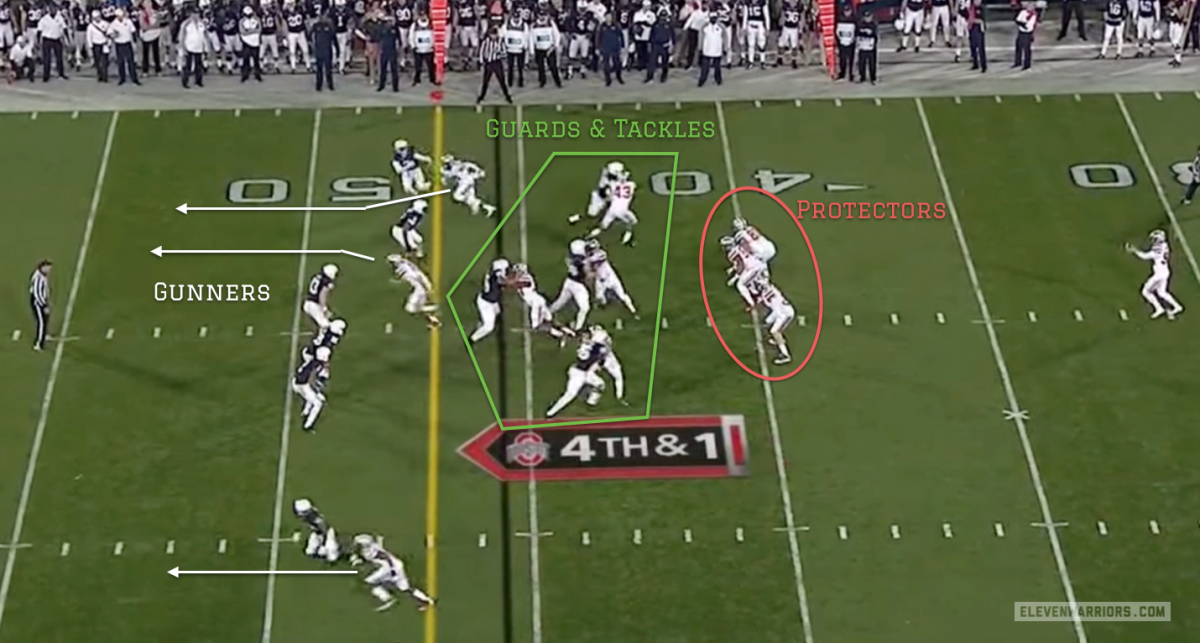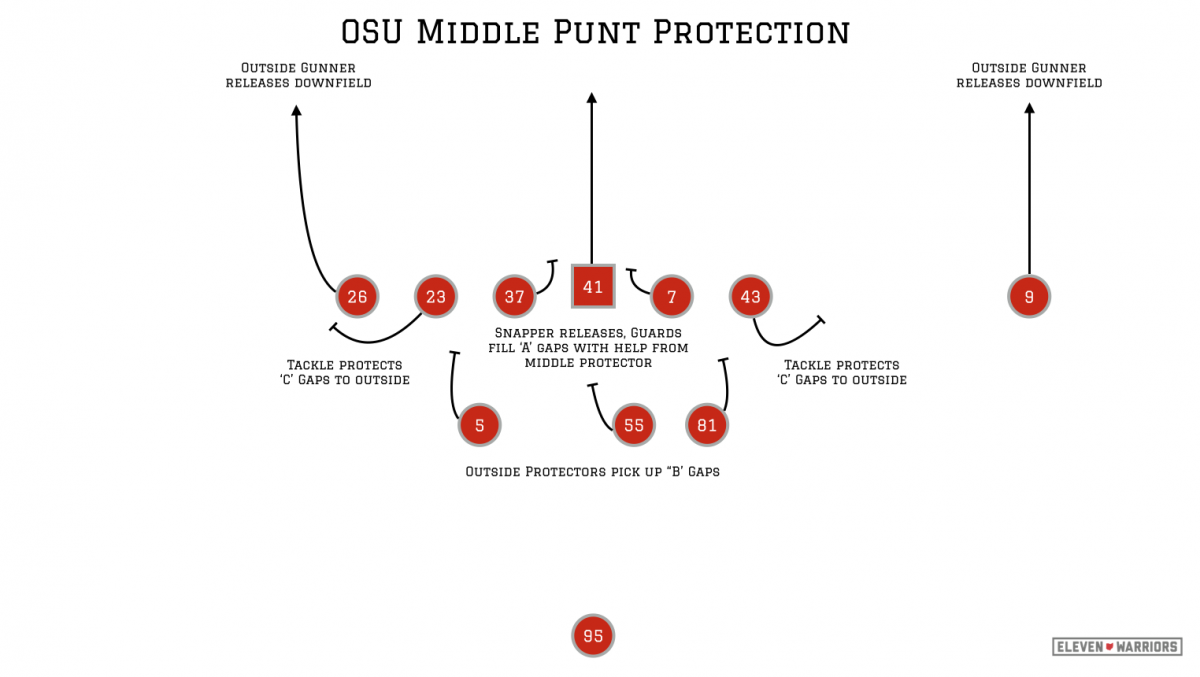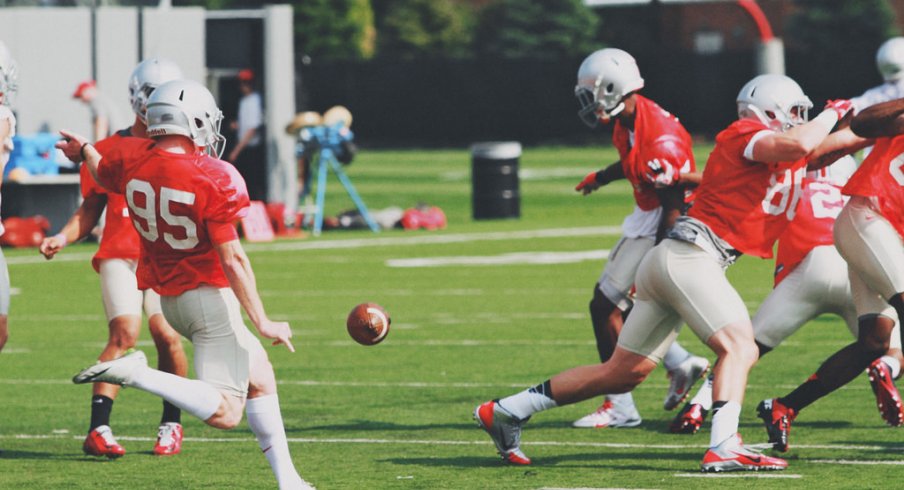Perhaps more than any other fanbase in the 21st century, followers of Ohio State football have been avid and willing celebrants of the punt.
With the hiring of Jim Tressel in 2001, the Buckeyes emphasized the importance of a play that could swing field position by as much as 50 yards at a time.
The 2002 national championship validated a 'defense and field position' mantra, which coincided with Andy Groom and B.J. Sander's efforts to re-write the school record books at the oft-overlooked position. But over time, this philosophy began to wear thin among fans nationally, often associating this conservative style with the Big Ten's lack of success on the biggest stages.
When Urban Meyer took over as the leader of the program in 2012, many would've expected the spread offense guru to put less emphasis on the third phase. Those fears appeared to come to life in an initial campaign that saw his team plagued by blocked punts, as countless young players were thrust into action while learning a new punt scheme.
However, as evidenced by the success of the kickoff team, the current head man in the Woody Hayes Athletic Center clearly takes this part of the game as seriously as did his sweater-vested predecessor. This focus is rarely highlighted though, as TV broadcasts often use that time to zoom in on a returner or continue discussion of the previous play, leaving fans fairly clueless about his approach to punting the ball away.
Due to the success of the aforementioned offense in 2014, the Buckeyes punted the fifth-fewest number of times in the country, seeing only the high-powered attacks of Oregon and Marshall and clock-chewing option systems of Navy and Georgia Tech kick the ball to their opponents less. As such, punter Cameron Johnston was rarely considered to be among the nation's finest at his position.
When looking deeper at the numbers though, Johnston registered the sixth longest average punt in the country at 45.08 yards-per-punt. While this number speaks volumes for the former Australian rules footballer's abilities, the most impressive stat coming from the Buckeye punt team was the fact that only 10 of his 48 kicks was actually returned. Additionally, 24 punts were downed inside the opponent's 20-yard-line, with only five kicks landing in the end zone for a touchback.
Johnston was an integral weapon in the field position battle for 2014's national champions, but he didn't do it alone. A well-executed punt is more than just a big boot as far downfield as possible, or aiming for a corner inside the five. To ensure success, the other members of the OSU punt team could also be found making plays elsewhere on the field, and in an extreme bit of irony when looking at the slow, plodding reputation of the play, these were also some of the best athletes on the team.
While many high school and pee-wee coaches simply keep their base offense on the field when punting, leaving offensive linemen on the field to prevent a blocked kick instead of covering downfield, many at the collegiate level have begun experimenting with different punt formations and tactics over the past decade. As he has in other phases of the game, Meyer has looked to gain any advantage he can in this area, with formational ploys that confuse the return team thanks to non-traditional alignments.

To execute such a scheme, Meyer effectively divides the punt team into four groups:
Specialists
When asked, most fans can often only name two specific positions on a punt team, the punter and his long snapper. With the exception of field goals and maybe kickoffs, these players rarely see the field elsewhere, and are recruited strictly for these roles.
While few can argue that punters have a skill set deserving of a scholarship, the debate continues for many programs about whether or not to allocate one of their 85 roster spots to a snapper. There is no such questioning on the OSU staff, as two such snappers will be on scholarship next fall when Liam McCullough join Bryce Haynes on the roster. One major reason is their ability to take on a second role on the coverage team.
Gunners
Traditionally manned by defensive backs or wideouts, the Buckeye long snappers also fill in this role thanks to a rule making it illegal to blast them right after the snap. While no one will mistake Haynes with Devin or Corey Smith, Haynes is asked to fill the same role as they do once he has released downfield.
The number one job of the gunners is to get downfield and keep the returner in front of them, forcing lateral movement instead of darting straight upfield after catching the kick. They aren't expected to make the tackle necessarily, but keep the return man from gaining any real ground until the rest of their teammates can get there to clean up.
Guards & Tackles
Though these players line up in the same spots as Taylor Decker or Pat Elflein, no one will be mistaking those two for this group. Outside linebackers Darron Lee and Josh Perry were joined by a rotating cast of Tyvis Powell, Dante Booker, Rod Smith, and even Ezekiel Elliott in these spots, tasked with making initial contact with any oncoming rushers before shedding that player and getting downfield to make a tackle.
Once downfield, this group stays in their assigned lanes, each three-to-five yards wide, hoping to force the returner to split a four-man wall of tacklers in order to gain any ground.
Protectors
The real last line of defense is made up of tight ends and linebackers, not the offensive linemen that many collegiate teams place between the snapper and punter. Jeff Heuerman and Nick Vannett regularly looked for any action that came through the "B" gap between the guard and tackle to their side, while Camren Williams often picked up anything that leaked through the middle. Additionally, Williams acted as the signal-caller for the unit, alerting the team of the snap while also tasked with announcing any audibles or adjustments that may be needed on the field.

When the 2014 season began, the Buckeyes regularly released three gunners downfield (including the snapper, Haynes), with Devin Smith always splitting out to the right. Armani Reeves manned the opposite gunner spot, yet would rotate between splitting out and lining up as the end man on the interior line (like a tight end) depending on the scouting report.

As seen in this example against Penn State, Smith and Haynes release downfield basically untouched, forcing a fair catch at the ten-yard-line thanks to a 48-yard punt. Such an outcome was clearly by design, as Meyer hinted after the previous game in Beaver Stadium, a night in 2012 that saw the Nittany Lions block a punt and return it for a touchdown.
"...our belief is you have 6.5 seconds," Meyer said. "If you're hitting the ball 4.5 seconds hang time, and 2 seconds get off, that's 6.5 seconds to cover 40 yards. You put really fast people out there and force catches. We're not doing that right now. But at the end of the day you would say what is the best punt? Fair catch."
With this thinking in mind, the MVP of the OSU punt team truly becomes not the punter or snapper, but the outside gunner(s). A deep, high kick is meaningless if the returner can't be stopped, and the best way to stop a return is by preventing one at all.
In this regard, there may have been no better player in the nation than Devin Smith over the past two seasons. While a 4.42-second forty and 30 career touchdown catches have made pro scouts pay attention, his ability to make a clean release off the line and get downfield in a hurry is a big reason for the second or third-round grade many pundits have given him for the upcoming NFL draft.
As injuries began to take their toll late in the regular season, Meyer looked to double-down on the approach of valuing gunners and forcing a fair catch. With Reeves and Heuerman in and out of the lineup, the Buckeyes began experimenting with their punt formation, eventually settling on a scheme that now released a fourth gunner downfield in Corey Smith.

With Johnston often stepping to his right (in the direction of his kicking foot) before getting the punt off, the left side of the formation became less important. This allowed the 'left tackle' to release as the gunner on the left while the left protector picked up any outside pressure from that side. To compensate, newcomer Raekwon McMillan lined up just behind the right hip of the right tackle as a wing, looking to set the edge on that side.
The center-point of the 'pocket' became the 'B' gap to the right, directly in front of where Johnston would kick. With only five players needed to protect this space, Corey Smith was inserted as a second gunner split out to the right.

The combination of the two Smiths on the outside proved unstoppable, and by the final four games of the season, this scheme had become the default for OSU. In that span, only two out of 17 Buckeye punts were returned, turning this unit into a major field-flipping weapon at the most critical time.
To properly summarize the success of not only the approach and execution of the unit, we can look no further than net punting average, which accounts for return yards.
| Name | School | Punts | Net Average | opponent returns |
|---|---|---|---|---|
| JK Scott | Alabama | 55 | 44.7 | 12 |
| Austin Rehkow | Idaho | 44 | 43.5 | 15 |
| Tom Hackett | Utah | 80 | 42.7 | 19 |
| Alexander Kinal | Wake Forest | 81 | 42.5 | 15 |
| Cameron Johnston | Ohio State | 48 | 41.8 | 10 |
Scott, Rehkow, and Hackett were the three finalists for the Ray Guy award, given annually to the nation's best punter, and Johnston belongs right there with them. Though all three return in 2015, there is no reason to believe the Aussie won't be in the conversation for the award next year, as he'll have the support of his teammates once again.
Like in many other phases, the 2015 iteration of the OSU punt team should look very much the same, as only Devin Smith moves on from the unit. While his contributions were immense, this opens up an opportunity for one of the young wideouts like Johnnie Dixon, Parris Campbell, Terry McLaurin, or James Clark to earn additional playing time.
With such continuity within the unit, look for Meyer to continue to tweak schemes and protections in an effort to get as many bodies downfield in a hurry while keeping Johnston upright. Although the Buckeyes may have shed their reputation of having a 'punt-happy' game plan, that doesn't mean they don't value it. Long live the punt.


